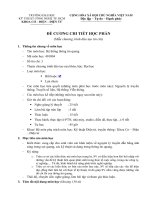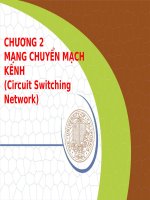Điện tử viễn thông c2 1 ky thuat chuyen mach kenh ditel khotailieu
Bạn đang xem bản rút gọn của tài liệu. Xem và tải ngay bản đầy đủ của tài liệu tại đây (126.19 KB, 20 trang )
TRƯỜNG ĐẠI HỌC ĐIỆN LỰC
KHOA ĐIỆN TỬ - VIỄN THÔNG
TỔNG ĐÀI &
KỸ THUẬT CHUYỂN MẠCH
Chương 2: Kỹ thuật chuyển mạch kênh
Giảng viên: Phan Thị Thanh Ngọc
1
EPU - 2012
Chuyển mạch ngang – dọc (Cross-bar)
Sô lượng chuyển mạch = n * m
2
J.Tiberghien - VUB
Chuyển mạch 2 cấp
1
100
20
*5
20
*5
20
*5
20
*5
20
*5
20
*5
20
*5
20
*5
20
*5
20
*5
1
100
Dung lượng chuyển mạch= 5*20*10 = 1000 <<< 10 000
(chuyển mạch ở đây là chuyển mạch khối)
3
J.Tiberghien - VUB
Chuyển mạch 3 cấp
1
n*
k
N/n*
N/n
n*
k
1
N/n*
N/n
N/n*
N/n
N
N/n
N*k
4
k
k*N2/n2
N
N/n
N*k
J.Tiberghien - VUB
Các chuyển mạch 3 cấp
A
n*
k
N/n*
N/n
n*
k
k
N/n*
N/n
B
N/n*
N/n
5
In both A & B, n-1 lines busy
None of the busy lines of A communicating with B
Free line of A wants to communicate with free line of B
Non blocking condition : k >= (n-1)+(n-1)+1 = 2n -1
J.Tiberghien - VUB
Three Level Switches
Optimal non-blocking N*N switch
6
Total Number of Switches S = 2Nk + kN2/n2
Non blocking
: k = 2n-1
S = 2N(2n-1) + (2n-1) N2/n2
S = 4Nn - 2N + 2N2/n - N2/n2
How to choose n to minimize S ?
dS/dn = 0
4N-2N2/n2+2N2/n3 = 0
(1-1/n)N/n2 = 2
for large n : n ~
2N - 1)
N/2 Sopt = 4N(
Example : N=100, S ~ 5200
J.Tiberghien - VUB
Traffic
Intensity
Traffic Intensity on a single line =
Fraction of time the line is busy
Expressed in Erlang (Danish mathematician)
Typical residential line (no internet) : 0.05 Erlang
Typical business line
: 0.2 Erlang
Typical GSM
: 0.035 Erlang
Traffic intensity in exchange = Traffic on lines
e.g. Exchange with 10 000 residential lines
Traffic = 500 Erlang
Capacity of a GSM cell expressed in Erlang/km2
7
J.Tiberghien - VUB
Little formula
h = mean duration of a call (line holding time)
λ = Call’s rate = number of calls per time unit
If T2 is the observation time and T1 the
occupancy time during T2, then
Number of calls during T2 = λ * T2
Occupancy time T1 during T2 = λ * T2 * h
Traffic = T1/T2 = λ * h
Example:
h = 4min; λ = 30 calls/min; A = 120 E.
h = 1min; λ = 120 calls/min; A = 120 E.
8
J.Tiberghien - VUB
Blocking
If the number of servers (i.e. lines) is smaller than
the number of users trying to make a call, some
traffic will be lost:
A0 = offered traffic
Ac = carried traffic
Ac = Ao if capacity is sufficient
Al = Ao - Ac = Lost traffic
B = Al / A0 = Blocking probability
or Grade of Service (GoS)
9
J.Tiberghien - VUB
The Erlang B law
Hypothesis :
Infinite number of sources.
Arrival = Poisson distribution.
Duration = h = Exponential distribution
A0n
B(n,A0) =
1
10
A0
1!
n!
A02
2!
...
A0n
n!
Often n is wanted as a function of A0 and B.
B(n,A0) is tabulated, so that n can be found,
J.Tiberghien - VUB
but often n should be multiple of 30 !
The Erlang B law
B = 1%
N
A0
5
10
30
60
75
90
120
180
11
1.36
4.46
20.3
46.9
60
74.7
103
160.4
J.Tiberghien - VUB
Probability
Graphs
p = probability (Lee Graphs)
that a link is busy (0..1)
= Traffic intensity on that link (Erlang)
q = probability that a link is idle
q=1-p
IF any of n links can be used to complete a call
Blocking probability B = pn
IF m serial links are needed to complete a call
Blocking probability B = 1 - qm
This supposes all probabilities are independent
12
J.Tiberghien - VUB
Three Level
Switches
With blocking probability
p'
p'
B
p
k
p
n lines
p' = p (n/k) = p/
B = probability all paths busy
B = (probability that arbitrary path busy)k
B = (1 -q'2)k = [1 - ( 1- p/)2]k
given p and B , this is a relation between k and n
13
J.Tiberghien - VUB
Three Level
Switches
With blocking probability
Nonp = 0.1
blocking
B=B
0.002
N
n
k
S
k
S
8 5
2 560 15
7 680
128
512 16 7 14 336 31 63 488
2 048 32 10 81 920 63 516 096
8 192 64 15 491 520 127 4.2 106
33 106
32 768 128 24 3.1 106 255
131 072 256 41 21.5 106 511 268 106
14
J.Tiberghien - VUB
Multistage
Switch
15
J.Tiberghien - VUB
Time Division
Switching
Telephone channels
multiplexed in 30 channel frames
8 7 6 5 4 3 2 1
8 7 2 5 6 3 4 1
1
(*)
(*)
8
(*) Delay = 125 S
16
J.Tiberghien - VUB
Time Division
MUX , Switching
Time Switch & DEMUX
Dual
access
RAM
memory
32 bytes
M
U
X
Write
Address
Slot
Counter
17
Read
Address
Control
store
32
addresses
J.Tiberghien - VUB
Hybrid
Switching
Space
- Time - Space
18
J.Tiberghien - VUB
Hybrid
Switching
Time
- Space - Time
19
J.Tiberghien - VUB
Telephone Exchange
(Conceptual Model)
Line Circuit
trunk lines +
Inter-office
signaling
Register
Line Circuit
Line Circuit
Line Circuit
Line Circuit
Switching
Matrix
Register
Register
Register
Control Computer
20
J.Tiberghien - VUB









